

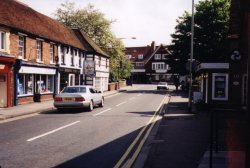
Pangbourne is one of our regular places to visit if we are out on the boat for a weekend or even for just a day. It caters for boaters very well, as a long stretch of the River Meadow is available for free mooring. The village which although small, has a good range of shops as well as pubs, small cafes and restaurants and is only a short walk away.
Like many of the villages on the banks of the Thames, Pangbourne has a long history. The first recorded mention of it is in a Saxon charter of 844. In fact the name derives from a Saxon word, Paegaingaburnan, meaning 'stream of the sons of Paega.' Paega was the leader of a Saxon group who settled on the site.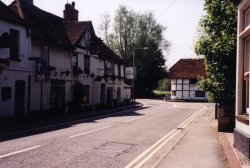
Nowadays the oldest buildings to be found are the cottages and the Cross Keys pub, opposite the parish church, which date from the 16th century.
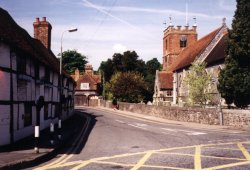
It was in one of the cottages, Church Cottage, that Kenneth Grahame, author of 'Wind in the Willows' lived earlier this century.
For centuries it was a very small quiet village. This all changed in 1840 with the coming of the railway. The Great Western Railway, built by Isambard Kingdom Brunel, had a station built just outside the village opposite the 17th century Swan pub. This meant that Pangbourne was now easily reached from London. It became a popular place for visiting anglers, artists and pleasure seekers. Anyone who has read Jerome K Jerome's novel 'Three Men in a Boat' may well remember that it was at Pangbourne that the gallant threesome ended their epic journey and hopped on the first train back to the metropolis.
Its popularity led to an increase in housing, including along Shooter's Hill, once a quiet lane running parallel to the river upstream of Whitchurch Lock, now the busy main road to Oxford. 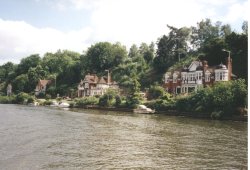 In 1896 an enterprising builder cut away a long stretch of the chalk cliff in order to erect seven Edwardian villas. These are known collectively as 'The Seven Deadly Sins'. One story suggests that they were built for the purpose of housing the mistresses of a member of the Royal Family, however, though it is a good tale it's not likely to be true.
In 1896 an enterprising builder cut away a long stretch of the chalk cliff in order to erect seven Edwardian villas. These are known collectively as 'The Seven Deadly Sins'. One story suggests that they were built for the purpose of housing the mistresses of a member of the Royal Family, however, though it is a good tale it's not likely to be true.
During World Wars 1 and 2 the river at Pangbourne was used to good effect in training American, Canadian, Australian as well as British Royal Engineers in the skill of building bailey and pontoon bridges. Prior to D-Day many bridges were built across the Thames and then dismantled.
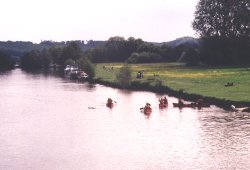
Thankfully, today more peaceful activities can be observed taking place on Pangbourne Meadow. During the weekend and many weekday evenings canoeists will be out receiving training from the experts at Pangbourne Outdoor Centre. In early May the Donkey Derby is held. This is fun to watch, though some of the donkeys seem less than keen to be taking part.
Pangbourne Fete is held over an entire weekend by the riverside during June. The village must have a very hard working committee to organise it, because this is an action packed few days, starting with a barn dance on Friday evening, various stalls to visit and displays to view during Saturday, followed by dancing to a blues band and a firework display in the evening. A fun weekend!
Even if no special event is being held, there will frequently be people out walking, fishing, feeding the ducks and generally relaxing and watching the world go by...a well recommended activity!
To proceed further upstream boats must pass through Whitchurch Lock. This is an ideal lock for learners to boat-handling, who might be put off by the onlookers usually found at a lock. Whitchurch is one of the few that doesn't have public access, so any blunders will only be seen by the lock keeper and other boaters.
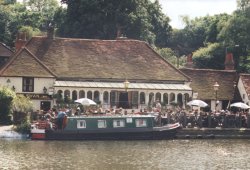
Just upstream of the lock is one of the fairly rare pubs found with riverside frontage.There is space for two or three boats. The Swan is an old establishment dating from 1642. In the days when barges carried goods along the river part of the pub was used as a grain store. Now it's a popular venue during the warm summer months with people enjoying a drink and a meal as they watch the activity on the river.
Click here to return to:
| Places to visit |
|---|
Copyright © The Harts